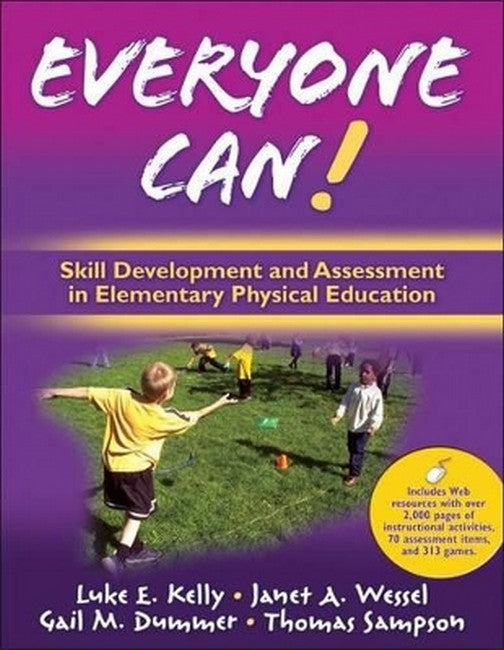Luke E. Kelly, PhD, is a professor of kinesiology at the University of Virginia in Charlottesville. He has 30 years of experience working with public schools on evaluating and revising their general physical education curricula to meet the needs of students with disabilities. He has written six books and numerous articles on topics related to training general physical educators. He also has developed and validated a Web-based motor skill assessment program that allows teachers to assess students' motor skills. Janet Wessel, PhD, is professor emeritus from MichiganStateUniversity. She has numerous publications in adapted physical education and has designed instructional systems and curricula for children with special needs. She has also presented I Can workshops and has developed and adapted program content, instructional design, and other activities relevant to cultural and educational settings. Dr. Wessel has received numerous awards over the years, including the Crystal Apple Honor Award in recognition of exceptional educators from the Michigan State University College of Education. Gail M. Dummer, PhD, is a just-retired kinesiology professor from MichiganStateUniversity. For the past 30 years, she has taught university-level courses, conducted outreach projects, and conducted research related to adapted physical activity. She served as the director of the Michigan State University Sports Skills Program, in which university students provide instruction and coaching in sports skills to people with disabilities. She has received numerous awards over the years, including the 2008 Professional Recognition Award from the Adapted Physical Activity Council of AAHPERD. Tom Sampson, PhD, is an assistant professor and chair of the education department at Olivet College in Olivet, Michigan. He is a former elementary physical education and adapted physical education teacher, and he has experience in implementing objective-based, outcome-driven curricula. He has also acted as a K-12 health and physical education curriculum coordinator and has been a field test teacher for the federally funded I Can adapted PE program.
Request Academic Copy
Please copy the ISBN for submitting review copy form
Description
Preface Acknowledgments How to Use This Book and Online Resource Part I: Everyone Can! Achievement-Based Curriculum (ABC) Chapter 1. ABC Program Planning Step 1: Establish a Program Philosophy, Goals, and Objectives Step 2: Assign Program Goal Emphasis Step 3: Determine Instructional Time and Average Objective Mastery Time Step 4: Calculate the Total Number of Objectives Per Goal Step 5: Finalize Program Scope and Sequence Step 6: Create Yearly Teaching Learning Maps Step 7: Identify Objective Assessment Items and Create Scoresheets Summary Chapter 2. Assessment Step 1: Determine What Objectives Should be Assessed Step 2: Select an Appropriate Assessment Instrument Step 3: Score and Record Performance Step 4: Select an Assessment Activity Step 5: Conduct an Assessment Activity Step 6: Conduct Other Forms of Assessment Summary Chapter 3. Implementation Planning Step 1: Set Student Initial and Target Learning Expectations Step 2: Identify Student Learning Needs Step 3: Create Instructional Groupings Based on Focal Points Step 4: Select Learning Activities Step 5: Design Teaching Templates and Student Learning formats Summary Chapter 4. Teaching Step 1: Get Ready Step 2: Maximize On-Task Time Step 3: Apply Essential Teaching Elements Step 4: Put It All Together Summary Chapter 5. Evaluation Step 1: Collect Reassessment Data Step 2: Calculate, Interpret, and Report Student Performance Step 3: Evaluate and Grade Students' Progress Step 4: Evaluate Your Program Step 5: Use Technology to Aid in Education Step 6: Establish Program Accountability and Justification Part II: Everyone Can! Online Resources Chapter 6. Model K-5 Program Plan Step 1: Develop Program Philosophy, Goals, and Objectives Step 2: Establish Program Goal Emphasis Step 3: Calculate Instructional Time and Average Mastery Time Step 4: Calculate Amount of Content to Include in the Curriculum Step 5: Sequence Content Across the Curriculum Step 6: Create Yearly and Block Teaching and Learning Maps Summary Chapter 7.Using the Everyone Can! Online Resource Materials How to Access the Everyone Can Online Resource Online Resource Menus Selecting an Objective from the Main Menu Exploring the Instruction Materials Using the Online Resources Methods for Printing Posters Other Uses for the Everyone Can Resources Using Everyone Can for Individualized Education Programs Summary Chapter 8. Incorporating the ABC Model Into Your Program Designing an In-Service Program Managing Change Summary About the Authors

